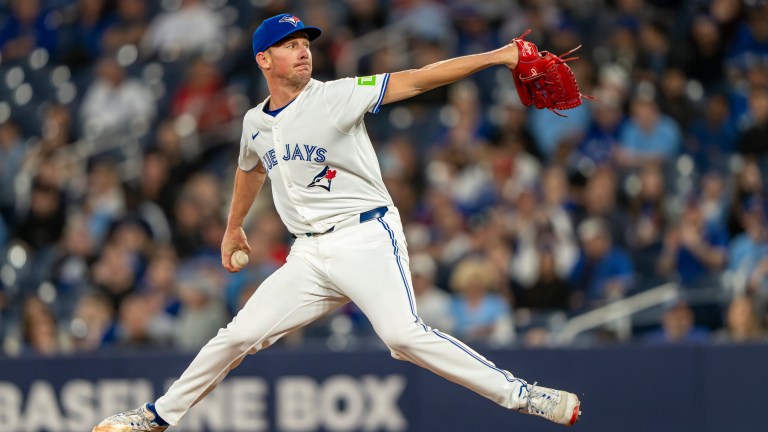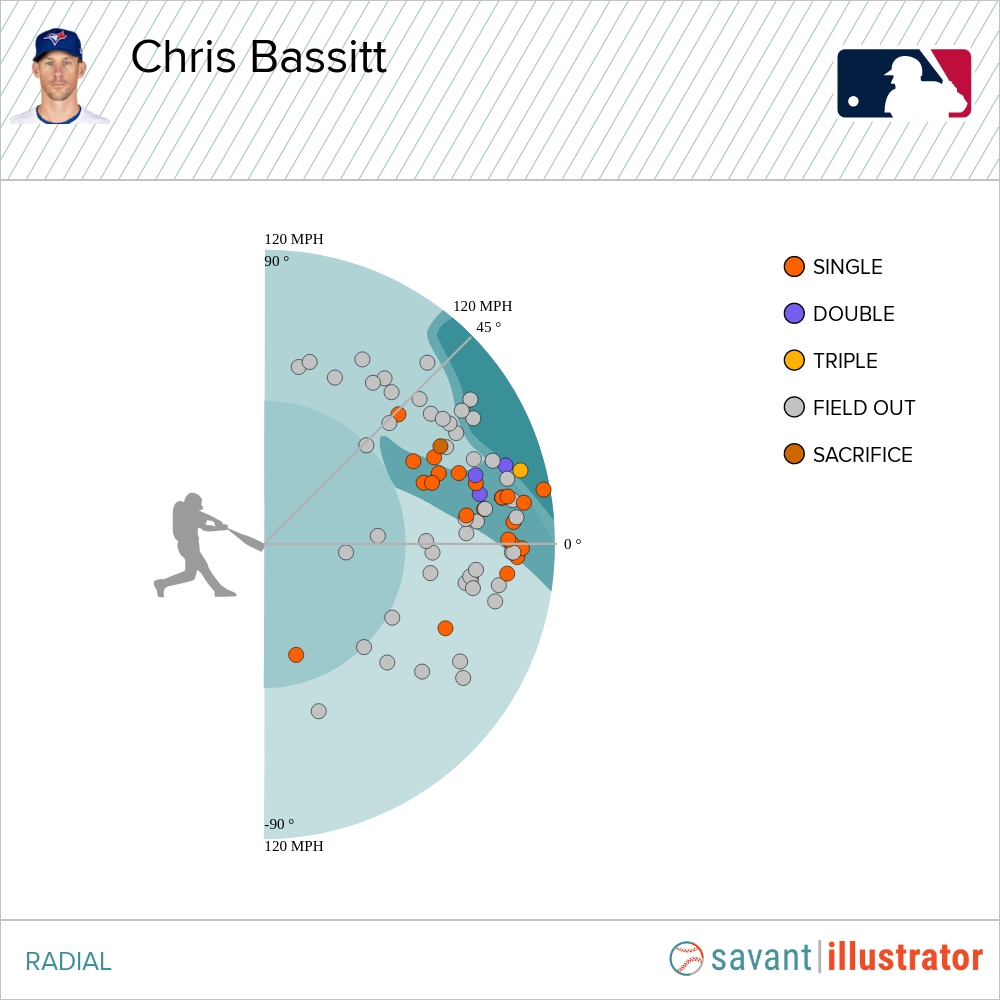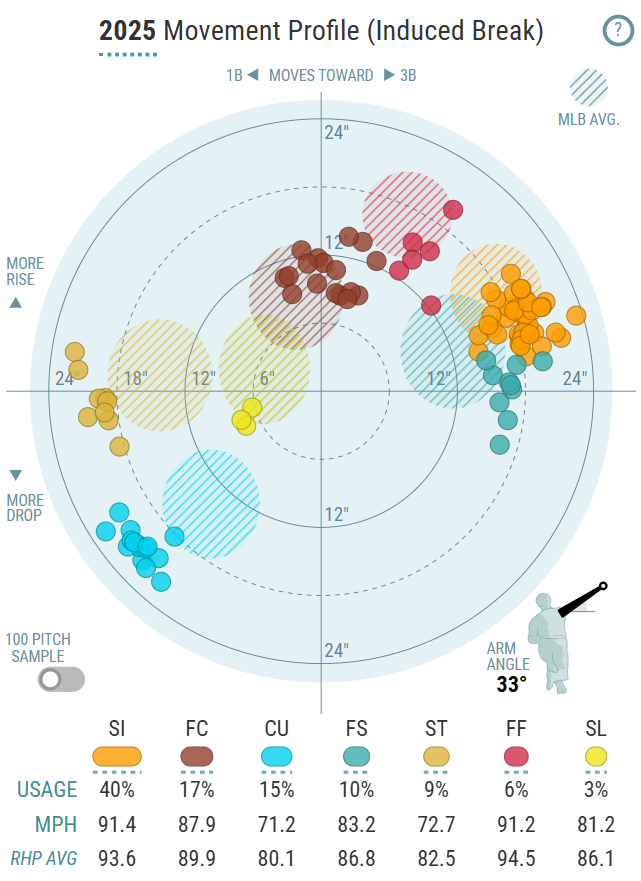Chris Bassitt Has Never Pitched Better Than He Has to Start 2025
Chris Bassitt has revitalized his pitch shapes, leading him to dominance at age 36. How has Bassitt become more deceptive in 2025?

Chris Bassitt is not shy about who he is as a pitcher. His confidence in his pitching style has helped the 36-year-old right hander emerge as Toronto’s ace in the early goings of the season.
Like any player in their mid-30s, Bassitt has seen a drop in pitch velocity over the recent years. In 2025, he ranks in the 12th percentile of average fastball velocity, averaging 91.4 mph with his heater. Throughout the 2020s, Bassitt has always been a low-velocity guy, as he has never ranked higher than the 43rd percentile in average fastball velocity.
In an age of rapid pitcher injuries and a chase for high pitch speeds, Bassitt has been adamant that sitting in the low 90s is better for long-term health.
In a 2024 interview with Jomboy’s Chris Rose, Bassitt emphasized MLB’s preference of “pitching over throwing” and the impact it has had on pitcher health.
“You have a natural human body that’s not made to say throw 95, 96, 97,” Bassitt said to Rose. “They’re made to throw 91-92, and that’s okay.”
Consistent with his work, Bassitt has been one of the most available pitchers in the Majors over the last half-decade. He ranks 11th in games started (137) and ninth in innings pitched (801.2) since 2020.
The Best Month of Chris Bassitt’s Career?
This year, Bassitt is not only available, but as effective as he has been in years. In six starts made in 2025, the Blue Jays starter ranks 10th among qualified starters in ERA (1.86) and his 1.49 FIP leads the Majors.
This low FIP can be explained by looking at Bassitt’s 23.5% K-BB% and his zero home runs surrendered. He is one of just two qualifiers yet to allow a long ball. It is the only six-game stretch in Bassitt’s career with 30+ strikeouts and an ERA under 2.00.
At 36 years of age, Bassitt’s 28.6% K% through the March/April 2025 month is tied for the fifth highest he’s posted in any month of his career. His 5.0% BB% ranks 10th highest on the same list. His 5.7 K/BB his the fourth highest he’s posted in a month and the highest since August of 2021.
When Bassitt hasn’t been missing bats this year’s he’s been inducing weak contact. 42.9% of batted balls he’s allowed this year have been clocked at or below 85 mph, the ninth-highest rate among the 143 pitchers with at least 50 batted balls allowed.

Bassitt’s 2025 radial chart shows an abundance of weakly hit fly balls and popups. There’s a reason he has not allowed a home run this season, opponents are not making the right contact when hitting the ball in the air.
In 2024, 19.8% of fly balls hit against Bassitt resulted in barrels, a ball with an exit velocity and launch angle combination with a leaguewide .500 batting average and 1.500 slugging. In 2025, that rate has dropped to just 12.5%, nearly have the Major League rate of 24.2%.
Also, last year, 27% of fly balls hit against Bassitt were hit to the pull side, a near-identical rate to the league average. So far this year, the rate has shrunk to 18.8%, its lowest since 2016.
According to statcast, fly balls hit to the pull side have a 30% higher chance of resulting in a home run compared to fly balls hit straightaway or to the opposite field. Bassitt is limiting ideal contact better than ever before.
How Bassitt is Using His Arsenal to Get Outs

Bassitt has made himself known for possessing a deep inventory when it comes to pitch selection. In 2024, he owned eight different pitches that he threw at least 125 times each. Some of his most valuable weapons have undergone some fine-tuning this year and have produced better results.
Revamped Sinker
Like in every season of his big league career, Bassitt is throwing his sinker more than any other pitch in 2025. Throughout his six starts this year, opponents are hitting .211 and slugging .237 against his most-used pitch.

Bassitt’s sinker had been a consistently reliable pitch for him, but that changed in 2024. Opponents hit .326 and slugged .422 against Bassitt’s sinker, giving it a negative Run Value per 100 pitches for the first time in his career.
Something needed to change if it was going to continue to be his primary pitch.
Through the first month of 2025, Bassitt’s sinker has shown more sink. Its average vertical drop has gone from 23.9 inches in 2024 to 27.2 inches in 2025.
Coupling that with its average of 17.4 inches of arm-side movement makes it one of the nastiest sinkers in baseball. Bassitt has thrown 122 sinkers with 25+ inches of drop and 15+ inches of arm-side movement, the fourth-most among all pitchers.
Slowed Down Cutter
Second in command behind Bassitt’s sinker is another fastball – his cutter. Like the sinker, this pitch is also moving differently this year. The average downward movement on Bassitt’s cutter went from 24.8 inches in 2024 to 26.3 inches in 2025. This additional sink came at the expense of nearly two mph, as its average velocity has dipped from 89.6 mph to 87.9 mph.
The extra sink has paid immediate dividends, as Bassitt’s cutter has produced a .115 opponents batting average against with no extra base hits allowed. Bassitt’s cutter also has a -1° average launch angle against, tied for the sixth lowest among the 121 pitchers with at least five batted balls recorded against their cutter.
More batters are getting on top of the ball as a result of the added drop.
Old Reliable: Bassitt’s Curveball
Following Bassitt’s cutter in usage is a curveball that he throws 15.3% of the time. Opponents are 3-21 (.143) against this pitch with no extra base hits. His curveball has also posted an 80.6 mph average exit velocity against and a 37.1% Whiff rate.
Put it all together and you have the best curveball in the Majors. Bassitt’s 3.9 RV/100 against his curveball ranks tied for first among the 38 pitchers with at least 10 plate appearances ending against curveballs.
Like the two aforementioned pitches, Bassitt’s curveball features above-average vertical drop, averaging 68.5 inches this year. It ranks tied for the second-most drop of any curveball in the majors this year. its 16.2 inches of average of glove-side movement, gives it some of the most unique movement of any pitch.
In 2025, Bassitt has thrown 53 curveballs with 65+ inches of drop and 15+ inches of glove-side movement. The rest of Major League Baseball has combined to throw 26 such curveballs.
Bassitt’s low velocity has helped him stay on the field throughout the 2020s. But this year, his added movement to his pitches, have made him more deceptive. It has given him the ability to combine his durability with dominance – a pair that, if sustainable, could make him one of the most valuable pitchers in the Major Leagues.
